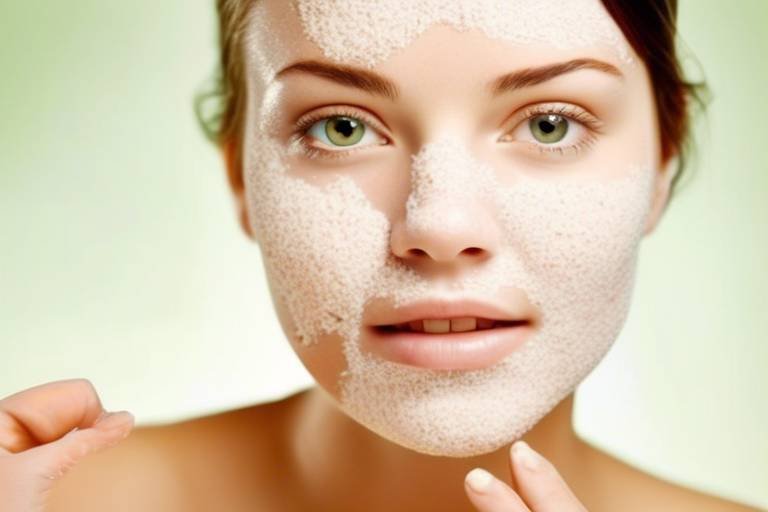How to Create a Sustainable Bathroom
Creating a sustainable bathroom is not only beneficial for the environment but also for your wallet. By incorporating eco-friendly practices and materials, you can reduce water waste, energy consumption, and your overall environmental impact. Let's explore some essential tips and strategies to help you design and maintain an environmentally conscious bathroom that is both functional and stylish.
One of the key aspects of a sustainable bathroom is the use of water-efficient fixtures. By installing low-flow toilets, faucets, and showerheads, you can significantly reduce your water consumption without compromising on performance or comfort. These fixtures are designed to optimize water usage, ensuring that you save water with every use.
When it comes to choosing materials for your bathroom, opt for eco-friendly options such as bamboo, reclaimed wood, and recycled glass. These sustainable materials not only add a unique touch to your space but also help minimize your environmental footprint. From flooring to countertops and fixtures, selecting sustainable materials can make a significant difference in the overall sustainability of your bathroom.
Maximizing natural lighting in your bathroom is another crucial step towards creating a sustainable space. By incorporating windows, skylights, and light tubes, you can reduce the need for artificial lighting during the day, saving energy and lowering your electricity bills. Natural light not only brightens up the space but also creates a more inviting and refreshing atmosphere.
Energy-efficient appliances play a vital role in reducing energy consumption in your bathroom. Choose appliances such as water heaters, ventilation fans, and lighting fixtures that are energy-efficient and have a minimal impact on the environment. These appliances are designed to operate more efficiently, helping you save energy and reduce your carbon footprint.
Proper ventilation is essential for maintaining a healthy and sustainable bathroom environment. Ensure good ventilation with exhaust fans and operable windows to prevent mold growth, improve indoor air quality, and enhance overall comfort. Proper ventilation also helps reduce humidity levels and prevents the buildup of harmful pollutants in the air.
Switching to green cleaning products is another simple yet effective way to make your bathroom more sustainable. Opt for environmentally friendly cleaning products that are non-toxic and biodegradable, reducing chemical pollution and promoting a healthier living environment for you and your family. These products are gentle on the environment while still providing effective cleaning results.
Implementing water-saving practices in your daily routine can also contribute to a more sustainable bathroom. Fixing leaks, taking shorter showers, and turning off the tap when not in use are simple habits that can help conserve water and reduce water waste. By being mindful of your water usage, you can make a significant impact on water conservation efforts.
Get creative with DIY upcycling projects to add a personal touch to your sustainable bathroom. Repurpose old items into new decor or storage solutions, giving them a new life while reducing waste. Upcycling not only adds a unique and stylish element to your bathroom but also promotes sustainability by minimizing the need for new materials.

Water-Efficient Fixtures
Creating a sustainable bathroom involves a combination of design choices and maintenance practices that aim to reduce water waste, energy consumption, and overall environmental impact. By incorporating eco-friendly elements into your bathroom, you can contribute to a greener future while also enjoying a stylish and functional space.
When it comes to water efficiency in the bathroom, installing low-flow toilets, faucets, and showerheads can make a significant difference. These fixtures are designed to conserve water without compromising performance or comfort. By reducing water usage, you not only save on your water bill but also help conserve this precious resource for future generations.
Additionally, incorporating dual-flush toilets can further enhance water efficiency by providing the option to use a lower volume of water for liquid waste and a higher volume for solid waste. This simple adjustment can lead to substantial water savings over time.
Another innovative solution is the installation of sensor-activated faucets, which automatically control water flow and help prevent wastage by turning off when not in use. These modern fixtures not only promote water conservation but also add a touch of convenience and sophistication to your bathroom.
Furthermore, consider recycling greywater from sinks and showers to flush toilets or water plants. This sustainable practice allows you to make the most of water that would otherwise go to waste, promoting a more efficient use of resources in your home.
By incorporating these water-efficient fixtures and practices into your bathroom design, you can play a vital role in promoting sustainability and reducing your environmental footprint.
If you have any questions about creating a sustainable bathroom or implementing eco-friendly practices, check out the following FAQs:
- Q: How can I determine if a fixture is water-efficient?
- A: Look for products that are labeled with the WaterSense certification, indicating that they meet water efficiency and performance criteria set by the Environmental Protection Agency (EPA).
- Q: Are water-efficient fixtures more expensive?
- A: While some eco-friendly fixtures may have a higher upfront cost, the long-term savings on water bills and environmental benefits often outweigh the initial investment.
- Q: Can I retrofit my existing fixtures to be more water-efficient?
- A: Yes, you can enhance the water efficiency of your current fixtures by adding aerators, flow restrictors, or other retrofitting devices that reduce water usage without the need for a complete replacement.

Eco-Friendly Materials
Tips and strategies for designing and maintaining an eco-friendly bathroom that reduces water waste, energy consumption, and environmental impact.
Installing low-flow toilets, faucets, and showerheads to conserve water without sacrificing performance or comfort.
When it comes to creating a sustainable bathroom, choosing the right materials is crucial. Opting for eco-friendly options such as bamboo, reclaimed wood, and recycled glass can significantly reduce the environmental impact of your space. Not only are these materials sustainable, but they also add a unique and natural touch to your bathroom decor. By incorporating eco-friendly materials into your design, you can create a stylish and environmentally conscious space.
Maximizing natural light through windows, skylights, and light tubes can not only enhance the aesthetic appeal of your bathroom but also help reduce the need for artificial lighting. By harnessing the power of natural light, you can lower your energy consumption and create a bright and inviting atmosphere in your bathroom.
Choosing energy-efficient appliances such as water heaters, ventilation fans, and lighting fixtures is essential for reducing electricity usage in your bathroom. By investing in appliances that are designed to conserve energy, you can lower your utility bills and minimize your environmental footprint.
Ensuring good ventilation in your bathroom is key to maintaining indoor air quality and preventing mold growth. By using exhaust fans and operable windows, you can promote air circulation and create a healthy environment in your bathroom.
Switching to environmentally friendly cleaning products is a simple yet effective way to make your bathroom more sustainable. By choosing non-toxic and biodegradable cleaning solutions, you can minimize chemical pollution and create a healthier space for you and your family.
Implementing water-saving practices like fixing leaks, taking shorter showers, and turning off the tap when not in use can significantly reduce water waste in your bathroom. By being mindful of your water usage, you can contribute to conservation efforts and lower your water bills.
Get creative with DIY upcycling projects to give your bathroom a unique and sustainable makeover. Repurposing old items into new decor or storage solutions not only reduces waste but also adds a personal touch to your space. From upcycled furniture to homemade storage containers, the possibilities are endless when it comes to incorporating upcycled elements into your bathroom design.
Do you have any questions about creating a sustainable bathroom? Check out our FAQs section below for answers to common queries on eco-friendly bathroom design and maintenance.

Natural Lighting
Natural lighting plays a crucial role in creating a sustainable bathroom design that is both eco-friendly and energy-efficient. By maximizing the use of natural light sources such as windows, skylights, and light tubes, you can significantly reduce the need for artificial lighting, thereby saving energy and lowering electricity costs. Natural light not only brightens up the space but also creates a warm and inviting atmosphere, enhancing the overall aesthetic appeal of the bathroom.
Strategically placing windows in the bathroom allows for ample natural light to enter, providing a sense of openness and connection to the outdoors. Skylights are another excellent option for introducing natural light from above, especially in bathrooms located in the interior of a building with limited access to exterior walls. Light tubes, also known as solar tubes or sun tunnels, are innovative devices that capture sunlight on the roof and channel it into the room through a reflective tube, illuminating the space with natural light.
In addition to reducing the reliance on artificial lighting, natural light offers numerous health benefits, such as boosting mood, enhancing productivity, and regulating the body's circadian rhythm. By harnessing the power of natural light in your bathroom design, you can create a harmonious and sustainable environment that promotes well-being and eco-conscious living.

Energy-Efficient Appliances
Tips and strategies for designing and maintaining an eco-friendly bathroom that reduces water waste, energy consumption, and environmental impact.
Selecting energy-efficient appliances such as water heaters, ventilation fans, and lighting fixtures can significantly lower electricity usage in your bathroom. By investing in appliances with high energy efficiency ratings, you not only reduce your environmental footprint but also save on utility bills in the long run.
Energy-efficient appliances are designed to consume less energy while providing the same level of functionality. For instance, opting for a low-flow showerhead can help you save water and energy without compromising on your shower experience. Similarly, choosing LED lighting fixtures over traditional incandescent bulbs can lead to substantial energy savings over time.
When shopping for energy-efficient appliances, look for products with the Energy Star label, which indicates that they meet strict energy efficiency guidelines set by the Environmental Protection Agency. These appliances are designed to perform optimally while using minimal energy, making them a smart choice for a sustainable bathroom.
In addition to reducing your carbon footprint, energy-efficient appliances can also enhance the overall aesthetic and functionality of your bathroom. By incorporating sleek and modern designs, these appliances can elevate the look of your space while contributing to a more sustainable lifestyle.
Moreover, investing in energy-efficient appliances is a proactive step towards creating a greener home environment. By making conscious choices in selecting appliances that prioritize energy efficiency, you are not only benefiting the planet but also setting a positive example for others to follow.

Proper Ventilation
Proper ventilation in a bathroom is crucial for maintaining a healthy and comfortable environment. Without adequate ventilation, moisture can build up, leading to mold growth and poor indoor air quality. To ensure proper ventilation, it is essential to install exhaust fans that can effectively remove excess moisture from the air. Additionally, operable windows can provide natural ventilation, allowing fresh air to circulate throughout the space.
Exhaust fans come in various sizes and styles, so it's important to choose one that is appropriate for the size of your bathroom. A properly sized exhaust fan will efficiently remove moisture and odors, helping to prevent mold and mildew. It's also essential to ensure that the exhaust fan is vented to the outside of the home, rather than into the attic or another enclosed space.
In addition to exhaust fans, skylights and light tubes can also contribute to proper ventilation by bringing in natural light and fresh air. Natural lighting not only reduces the need for artificial lighting but also creates a more inviting and energy-efficient space. By maximizing natural light, you can enhance the overall ambiance of your bathroom while reducing energy consumption.

Green Cleaning Products
When it comes to creating a sustainable bathroom, one of the key aspects to consider is the use of . These products play a crucial role in ensuring that your cleaning routine is not only effective but also environmentally friendly. By opting for environmentally friendly cleaning products, you can minimize chemical pollution and promote a healthier living environment for you and your family.
Green cleaning products are typically formulated using non-toxic and biodegradable ingredients, making them safer for both your health and the environment. These products are free from harsh chemicals that can contribute to indoor air pollution and have harmful effects on aquatic ecosystems when washed down the drain.
When shopping for green cleaning products, look for labels that indicate eco-friendly certifications or third-party endorsements to ensure that the products meet stringent environmental standards. These certifications can help you make informed choices and select products that are truly sustainable and safe to use in your home.
In addition to being better for the environment, green cleaning products are also gentle on surfaces and materials, helping to extend the lifespan of your bathroom fixtures and finishes. With their biodegradable nature, these products break down naturally without leaving behind harmful residues that can accumulate over time.

Water-Saving Practices
When it comes to creating a sustainable bathroom, implementing water-saving practices is crucial in reducing water waste and promoting eco-friendliness. One simple yet effective way to conserve water is by fixing any leaks in faucets, toilets, or pipes promptly. Even a small leak can waste a significant amount of water over time, so addressing them promptly is essential.
Another water-saving practice is to be mindful of your water usage habits. Taking shorter showers can make a big difference in water conservation. Consider installing a shower timer to help you keep track of your shower duration and reduce unnecessary water consumption. Additionally, turning off the tap while brushing your teeth or lathering soap can also contribute to saving water.
Furthermore, incorporating water-efficient fixtures in your bathroom can significantly reduce water usage without compromising performance. Low-flow faucets, toilets, and showerheads are designed to minimize water flow while maintaining adequate water pressure, ensuring a sustainable and comfortable experience.
Implementing dual-flush toilets is another effective water-saving strategy. These toilets offer two flushing options - one for liquid waste and another for solid waste, allowing you to use the appropriate amount of water for each flush. This simple adjustment can lead to substantial water savings over time.
Consider collecting and reusing greywater from your bathroom for activities like watering plants or cleaning outdoor surfaces. Greywater is wastewater generated from activities like bathing and washing hands, which can be repurposed for non-potable uses, reducing the overall demand for fresh water.
By incorporating these water-saving practices into your bathroom design and daily routine, you can contribute to water conservation efforts and create a more sustainable living environment for yourself and future generations.

DIY Upcycling Projects
When it comes to creating a sustainable bathroom, DIY upcycling projects can be a fun and creative way to reduce waste and give your space a unique flair. Upcycling involves repurposing old items into new, functional pieces for your bathroom décor. Not only does it help minimize waste, but it also adds a personal touch to your space that store-bought items simply can't match.
One popular upcycling project is turning old mason jars into stylish storage containers for toiletries or bath salts. By adding a coat of paint or decorative labels, you can transform these jars into chic accessories that also help you stay organized. This simple project not only reduces the need for new storage containers but also adds a touch of vintage charm to your bathroom.
Another creative idea is repurposing an old wooden ladder as a towel rack. By sanding down the ladder and giving it a fresh coat of paint, you can create a unique and functional piece that adds character to your bathroom. The rungs of the ladder can hold towels or even decorative baskets for extra storage, making it both practical and visually appealing.
If you have old wooden crates lying around, consider stacking and mounting them on the wall to create rustic shelves for displaying plants, candles, or other bathroom essentials. This project not only gives new life to unused crates but also adds a touch of warmth and texture to your bathroom décor.
For a more whimsical touch, you can upcycle old picture frames into decorative mirrors or jewelry holders. By removing the glass from the frames and adding hooks or wire, you can create unique pieces that reflect your personal style while reducing the amount of waste that ends up in landfills.
Upcycling projects not only allow you to express your creativity but also contribute to a more sustainable lifestyle by giving new life to old items. By incorporating these DIY projects into your bathroom design, you can create a space that is not only eco-friendly but also uniquely yours.
Frequently Asked Questions
- What are some benefits of creating a sustainable bathroom?
Creating a sustainable bathroom not only helps in reducing water waste and energy consumption but also contributes to minimizing your environmental impact. By using water-efficient fixtures and eco-friendly materials, you can lower your utility bills, improve indoor air quality, and support a healthier planet.
- How can I make my bathroom more eco-friendly?
You can make your bathroom more eco-friendly by incorporating water-efficient fixtures like low-flow toilets and faucets, using natural lighting to reduce energy usage, opting for energy-efficient appliances, and implementing water-saving practices. Additionally, choosing green cleaning products and upcycling old items for DIY projects can further enhance the sustainability of your bathroom.
- Are sustainable materials more expensive?
While some sustainable materials may have a higher upfront cost, they often provide long-term savings through reduced utility bills and maintenance expenses. Moreover, the durability and eco-friendly nature of these materials can add value to your home and contribute to a healthier living environment.



















